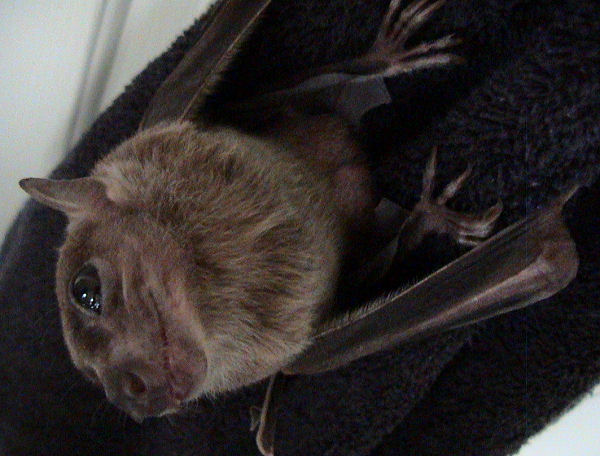|
| Query: pteropodinae | Result: 3rd of 3 | |
Egyptian Fruit Bat (Rousettus aegyptiacus) - Wiki
| Subject: | Egyptian Fruit Bat (Rousettus aegyptiacus) - Wiki
| |

| Resolution: 600x456
File Size: 71238 Bytes
Date: 2006:01:27 14:09:34
Camera: DCR-TRV740 (SONY)
F number: f/1.6
Exposure: 1/60 sec
Focal Length: 33/10
Upload Date: 2008:03:04 10:47:48
|
ERROR : Server Busy(-1105)
ERROR : Server Busy(-1105)
Egyptian Fruit Bat (Rousettus aegyptiacus) - Wiki
Egyptian fruit bat
From Wikipedia, the free encyclopedia
Order: Chiroptera
Family: Pteropodidae
Subfamily: Pteropodinae
[Photo] Egyptian Rousette or Egyptian Fruit Bat, Rousettus aegyptiacus. Date: 27 January 2006. Photographer: http://en.wikipedia.org/wiki/User:Dawson
The Egyptian Fruit Bat or Egyptian Rousette (Rousettus aegyptiacus) is a species of Old World fruit bat found throughout Africa, except in the desert regions of the Sahara, and throughout the Middle east, as far east as Pakistan and northern India. Due to their extensive geographic range, and relatively large wild population, Rousettus aegyptiacus does not hold any specific conservation status.
Description
Egyptian fruit bats are small compared to some of their megachiropterid cousins. They have a wingspan that averages 60cm, and a body length around 15cm. Weight is typically around 160g. Males are larger than the females and can be easily distinguished by their large scrotal sack. They are typically a light brown in color, with darker brown wings. They have large pointed ears, dark eyes, and a long dog-like muzzle - which sometimes leads them to be referred to as flying foxes. Their fur is very soft, and their wings feel not unlike pantyhose.
Behaviour
Like all bats, Egyptian fruit bats are nocturnal. They spend their days roosting in trees or caves, often with large groups of other bats, sometimes numbering in the thousands. They emerge from the roost to forage for food in the late evening, and return just before dawn. They hang upside down, with their wings folded closely around their body.
Egyptian fruit bats, like other species in the genus Rousettus, are the only megachiropterid bats to use echolocation, which they accomplish by emitting a series of sharp clicks with their tongue. The clicks are normally slow and constant and speed up dramatically when the bat approaches an object. They also make use of a range of vocalizations for communication, including grunts and screeches. It can be a cacophony of noise around a large roosting colony.
Diet
Egyptian fruit bats are frugivorous, consuming large amounts of fruit each night. Wild dates tend to be a favorite, but they will consume almost any soft, pulpy fruit.
Reproduction
Maturity is reached at about 9 months of age. Females typically give birth to only a single baby each year, but twins are occasionally born, after a gestation period of around 115-120 days. The young are carried by the female until they able to hang from the roost on their own (after about six weeks), then they are left in the roost while the mother forages for food. Once the baby bat can fly, at about three months of age, it will leave the roost on its own to hunt for its own food. Offspring typically stay with the same colony as the parents for their entire lives.
In captivity
The Egyptian fruit bat is well represented in zoos around the world. They breed readily in captivity and easily adapt to a captive diet of more commonly available fruits and nectar.
Concerns
These bats, as well as many other fruit eating bats are a concern because they are, in many cases, important pollinators or seed propagators for various species of tree and plant. The baobab tree for instance, relies almost exclusively on fruit bats to disperse its seeds. Unfortunately, fruit bats also consider human produce farms to be an easy source for food, and they are consequently poisoned or otherwise eliminated by farmers to prevent loss of crops.
http://en.wikipedia.org/wiki/Egyptian_fruit_bat
| The text in this page is based on the copyrighted Wikipedia article shown in above URL. It is used under the GNU Free Documentation License. You may redistribute it, verbatim or modified, providing that you comply with the terms of the GFDL. |
|
Comments |
|---|
| | Guest |
|
| cool awsome dude |
| | Guest |
|
Scientific Name: Rousettus aegyptiacus (E. Geoffroy, 1810)
Common Names: Egyptian Fruit Bat, Egyptian Rousette
Synonyms: Rousettus egyptiacus (É. Geoffroy, 1810) |
^o^
Animal Pictures Archive for smart phones
^o^
|
|
|

